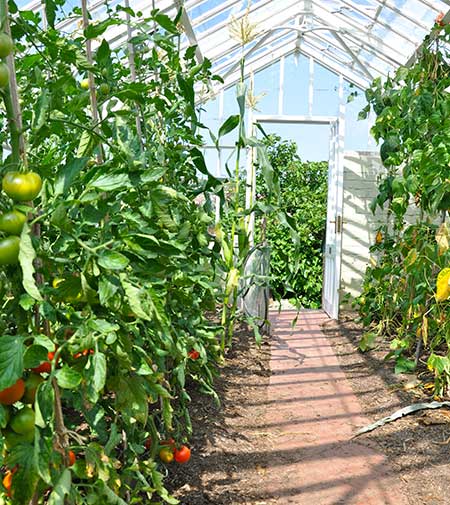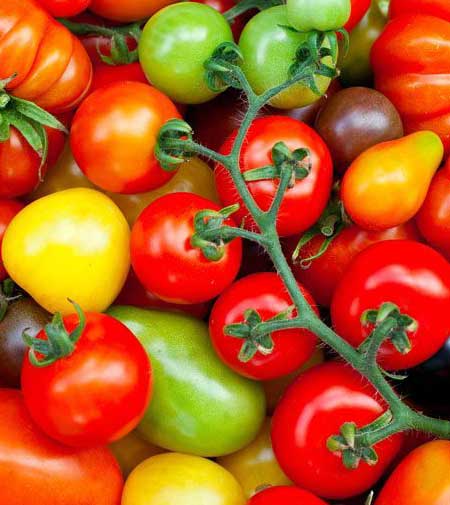Tomatoes
How to grow
Tomatoes would easily be the most popular vegetable grown in the home garden. There is also something immensely satisfying about picking your own tomatoes for months on end. They produce more than other vegetables from a small space with yields of 5 kg per plant not being uncommon.
At a Glance
- Must have a warm, sunny position
- Need a free-draining soil
- Require regular watering and feeding

Selecting the Site
- Tomatoes grow best in a warm, sunny position.
- Grown in a glasshouse produces best results.
- If you're growing them outside, they should not be grown in the same area of soil for 2 years in a row. It is best to move them to a new site each year and return to each site one year in four.
Soil
Tomatoes grow in most soils but the usual rules apply. They require good drainage, compost added to improve structure and the planting area raised in clay soils.
Ideally, fresh clean soil should be used in your glasshouse each year. The new soil should be made firm before planting and firmed again after planting.
Work into the soil before planting with Tui Tomato Food or Dynamic Lifter, together with a dressing of Lime.
The Plants
Tomatoes can be grown from seed or purchased as plants.
Always buy sturdy plants that have a short space between leaf joints, and if the plant measures nearly as much across from leaf tip to leaf tip, as it is high, you can be sure it has not been grown in an over-crowded situation. Nichol’s tomato plants are grown here in the south.
There are many varieties with fruit which varies in size, shape, taste, colour, acidity, as well as the growing habit of the plants, so if you are a tomato fanatic try the different varieties until you find your favourite - it can be fun.
The aristocrats of the tomato family are our ’X Generation’ grafted tomato plants which are strong and healthy - and the healthier the plant, the more resistant it is to diseases.

Popular varieties:
- ‘Money Maker’ is the most popular of the tall staked varieties. It has medium, large, round, fleshy fruit of good flavour.
- ‘Sweet 100’ is a tall variety with bunches of small fruit which hang like grapes.
- ‘Roma’ is the traditional egg shaped fleshy, non-acidic tomato, popular for cooking and sauce making.
- ‘Tasty Tom’ is a disease resistant variety, with a full rich flavour, and is a very heavy cropper.
- 'Big Beef'
- 'Te Anau'
- 'Sun Gold'
- 'Russian Reds'
When to Plant
Being a warm weather crop, tomatoes don’t really start growing until temperatures are up to ~20°C with night time minimums above 10°C. They can therefore continue to be planted from late September onwards in most areas. Successive plantings, about 6 weeks apart until early January, will ensure a good supply of tomatoes through until the end of May or sometimes later.
How to Plant
- Plant each tomato plant at least 5cm deeper than it was in the punnet.
- Plants are best planted out 50 to 60cm apart.
- Good ventilation is essential to avoid fungal attacks so do not plant your tomatoes too close together as this will generally produce a poor crop.
Feeding
Tomatoes will yield much more if they are well fed so in addition to the fertiliser applied prior to planting, commence weekly liquid feeding with Nichols Super Crop Tomato Food once the first truss of fruit has formed. An alternative solid feeding would be Tui Sheep Pellets.
Watering
Tomatoes require lots of water regularly. Once established, they must not be allowed to dry out as this drastically reduces yield. Irregular watering leads to blossom end rot - a sunken black patch on the bottom of the fruit.
Water daily in hot weather once fruit has developed, however, do NOT over water in the early stages – small plants don’t need much water. Over watered soil is much too cold for tiny new roots to grow away strongly.
After Care
Tomatoes need to be supported by tying to a stake or fence. Some gardeners use a stake and tie the two main tomato stems to the stake at 30cm intervals. Alternatively, twine the tomato plants up strong strings hanging from the glasshouse roof.
The two main stems come from the central leader of the young plant plus the first lateral or side shoot. Once these two stems are established all other side shoots (laterals) should be pinched out to keep the plant tidy and manageable.
Pinching out the new side shoots should be done twice a week as they can get out of hand very quickly.
Pests & Diseases - Troubleshooting
Many problems with tomatoes are associated with temperature, watering and feeding.
For a description and suggested remedies to the most common problems read our Tomato Trouble-shooting article.
7776